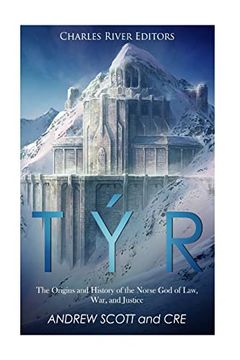Týr: The Origins and History of the Norse god of Law, War, and Justice (en Inglés)
Reseña del libro "Týr: The Origins and History of the Norse god of Law, War, and Justice (en Inglés)"
*Includes pictures *Includes medieval accounts *Includes online resources and a bibliography for further reading "Yet remains that one of the sir who is called Týr: he is most daring, and best in stoutness of heart, and he has much authority over victory in battle; it is good for men of valour to invoke him. It is a proverb, that he is Týr-valiant, who surpasses other men and does not waver. He is wise, so that it is also said, that he that is wisest is Týr-prudent. This is one token of his daring: when the sir enticed Fenris-Wolf to take upon him the fetter Gleipnir, the wolf did not believe them, that they would loose him, until they laid Týr's hand into his mouth as a pledge. But when the sir would not loose him, then he bit off the hand at the place now called 'the wolf's joint;' and Týr is one-handed, and is not called a reconciler of men." Much of what is known of the Norse myths comes from the 10th century onwards. Until this time and, indeed, for centuries afterwards, Norse culture (particularly that of Iceland, where the myths were eventually transcribed) was an oral culture. In fact, in all Scandinavian countries well into the thirteenth century laws were memorized by officials known as "Lawspeakers" who recited them at the "Thing." The Thing was the legislative assembly in Scandinavia "held for judicial purposes." One of the most famous of these Lawspeakers was the Icelander Snorri Sturluson, a masterful writer who wrote the Prose Edda in the thirteenth century. There are other sources for the Norse myths, namely the later "Poetic Edda," a collection of poems and prose work, and other sagas but the Snorri's Prose Edda is the most complete work whose attribution is known to modern scholars. The Prose Edda is a collection of Norse Myths split into three sections, the Gylfaginning (the Deluding of Gylfi), the Skáldskaparmál (the Language of Poetry) and the Háttatal (the Enumeration of Meters). The first has a frame story that entails a Swedish King, Gylfi, disguising himself as an old man, Gangleri, when he journeys to Asgard to meet the gods. When he arrives, he meets three men - "High One, Just-As-High, and Third" - who reveal to him stories of the world and the gods. The second section contains a warning for Christians not to believe in the Norse gods, specifically the two families, the sir and the Vanir, but also refutes the notion that they were demons, which was a common supposition among some Christians at the time. The Prose Edda begins in this line of thought with a euhemeristic prologue, which traces the history of the Norse Gods as human heroes of Troy, making Thor one of King Priam's sons. Timeless characters like Thor, Loki, and the All-Father Odin never fail to inspire new treatments of their stories, while many of the great characters from Norse myths wither, their secrets kept silent. Such secrets are inherent to the character of Týr. More closely aligned with the Greek Athena than Mars or Ares, Týr was once so highly regarded and devoutly worshiped that his name was synonymous with "godlike". "Týr-valiant" and "Týr-prudent" are but two of many such examples. Moreover, unlike most gods of war, Týr has much to offer modern historians in terms of religious practices, cultural unity, and the question of justice in northern Europe. Týr: The Origins and History of the Norse God of Law, War, and Justice looks at the stories about the legendary Norse deity. Along with pictures depicting important people, places, and events, you will learn about Týr like never before.

